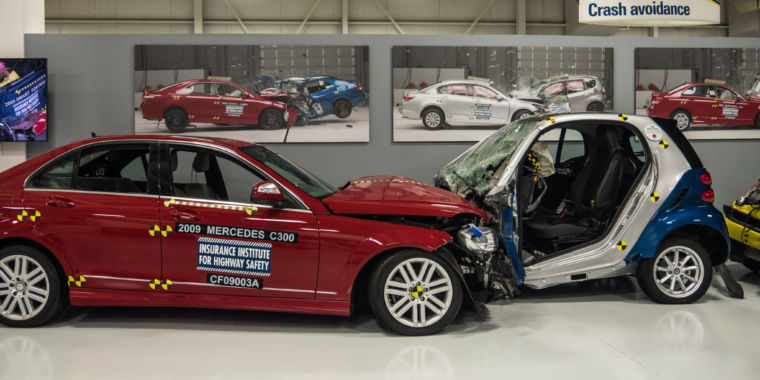
-
A row of crash-tested vehicles at the IIHS Vehicle Research Center in Virginia.Jonathan Gitlin
-
This used to be a 1959 Chevrolet Bel Air, built in the same year IIHS was founded. You can just make out some of the front left wheel, which now occupies the driver’s footwell. This is not an accident from which the Bel Air’s driver would have walked away.Jonathan Gitlin
-
The test dummies’ heads are covered in pink and blue greasepaint, which leaves a mark on anything it comes into contact with. In this case, that’s the hard metal dashboard of the Bel Air.Jonathan Gitlin
-
By contrast, the 2009 Chevrolet Malibu that collided with the Bel Air is in much better shape, and its driver would have survived.Jonathan Gitlin
-
A crash-test dummy.Jonathan Gitlin
-
Each dummy is filled with sensors.Jonathan Gitlin
-
And the crash-test kids.Jonathan Gitlin
-
IIHS’ moderate offset frontal impact test crashes cars into aluminum-honeycomb structures like this one.Jonathan Gitlin
-
The test does a good job of simulating an impact with a car of the same mass.Jonathan Gitlin
-
However, there’s no escaping physics. IIHS says the data is unequivocal—when vehicles of different sizes collide, the smaller one will always do worse.Jonathan Gitlin
-
For instance, this Smart Fortwo got a good rating in the offset front impact test in 2008.Jonathan Gitlin
-
The following year, IIHS crashed a Smart Fortwo into a Mercedes-Benz C-Class.Jonathan Gitlin
-
The same car that did well hitting an aluminum crash structure at 40mph performed far worse when hitting a larger vehicle at the same speed. IIHS carried out similar tests crashing a Honda Fit into a Honda Accord and a Toyota Yaris into a Toyota Camry. In each case, the small cars (which scored Good when tested alone) scored Poor.Jonathan Gitlin
-
Several of the facilities’ golf carts sport fancy grills.Jonathan Gitlin
-
On to a better place.Jonathan Gitlin
RUCKERSVILLE, Va.—The wrecked remains of a 1959 Chevrolet Bel Air provide a stark illustration of just how far we’ve come with regard to automotive safety. The copper-colored scrap greets you in the reception area of the Insurance Institute for Highway Safety’s Vehicle Research Center, an automotive safety testing facility nestled between farms in the bucolic Virginia countryside a couple of hours from Washington, DC. IIHS was set up in 1959 by the insurance industry to work on improving the safety of our vehicles, and to celebrate its 50th anniversary, the institute crashed the Bel Air into its then-current equivalent—a 2009 Chevrolet Malibu. The institute did this to prove conclusively that “they don’t build them like they used to. They build them better,” to quote IIHS’ then-president, Adrian Lund.
The mangled remains of the Bel Air aren’t pretty. A wheel and tire mostly occupy the space that should be the driver’s footwell. The metal dashboard to the left of the steering wheel is covered in pink and blue greasepaint from where the dummy’s head made contact. The 2009 Malibu, while also a wreck, left its dummy in much better shape, thanks to seatbelts, airbags, and energy-absorbing crash structures. And yet, it too is eclipsed in the safety stakes by almost every vehicle on sale in 2019, in no small part thanks to the work conducted at the institute.
IIHS opened the Vehicle Research Center in 1992, and since then it has been smashing cars into things (and things into cars) in the name of improved safety. The institute is constantly studying real-world crash data and designing new crash tests as a result, and its tests make automakers sit up and pay attention. That’s because safety sells in 2019, and the OEMs know they have to ace IIHS’ tests if they want to earn its coveted “Top Safety Pick” or the even-tougher “Top Safety Pick+” badge of honor.
You might be wondering why IIHS even needs to crash-test cars in the first place; after all, isn’t that the government’s job? The program came about in 1995 after researchers noticed that most frontal collisions were offset—unlike the National Highway Safety Administration’s New Car Assessment Program (NCAP) 35mph (56km/h) frontal impact test. NCAP’s test was (and is) an effective measure of how a car’s airbags and seatbelts protect the front-seat occupants. But because the force is equally distributed across the width of the vehicle, it is a less demanding test of how well a car’s structure absorbs or redirects energy away from the humans inside.
So IIHS decided to start testing vehicles by crashing them (into a deformable aluminum honeycomb structure) at 40mph (65km/h) with a 40% frontal offset. The institute found something rather shocking—vehicles that scored well in NCAP did not necessarily ace the IIHS test. In fact, more than half of the cars it tested in this moderate overlap test got a marginal or poor result. (IIHS rates each test result as good/acceptable/marginal/poor, and it says that a driver in “a vehicle rated good in the moderate overlap test is 46 percent less likely to die in a frontal crash, compared with a driver of a vehicle rated poor.”)
Listing image by Jonathan Gitlin
https://arstechnica.com/?p=1511379

